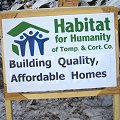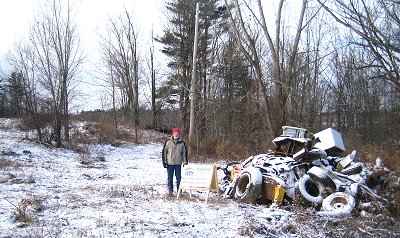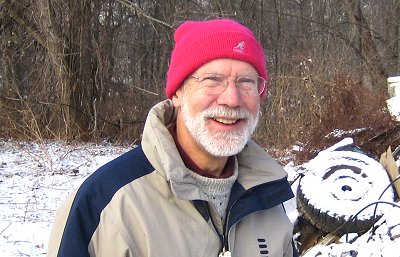- By Dan Veaner
- Around Town
 Print
Print  Since habitat For Humanity was founded by Millard and Linda Fuller in 1976, the organization has built more than 300,000 houses in more than 90 countries around the world for more than 1.5 million people. The houses are built largely by volunteers, one house at a time. Next year one will be built in North Lansing.
Since habitat For Humanity was founded by Millard and Linda Fuller in 1976, the organization has built more than 300,000 houses in more than 90 countries around the world for more than 1.5 million people. The houses are built largely by volunteers, one house at a time. Next year one will be built in North Lansing."What we usually do is try and select a family for the house, then build the house for the family, within reason," says Tompkins County Construction Coordinator Ed Siemon. "We're looking at plans for a three or four bedroom house, depending on how we divide it. That's the family size we usually get involved with. We try to make it a simple house in terms of building structure, because it will be built by volunteer labor."

The space for a house (left) was cleared last month,
leaving a huge pile of trash that had been dumped
on the site over many years
The property is a seven acre site that the local Habitat For Humanity chapter got at auction from Tompkins County, which obtained the property in a foreclosure proceeding. The County held the land while establishing a conservation easement on about five and a half acres of wetlands. As a result there is only enough usable space to build one house on the remaining acre and a half, though Siemon had hoped there would be room for two.
The first step was to clear the property, which had been used as an illegal dump for years. Habitat For Humanity affiliates from Cornell and the Ithaca First Congregational Church came out in mid-November to help dig out a potpourri of junk, including 30 tires, parts of a motorized dirt bike, bicycles, rugs, a refrigerator, baby diapers, and a Maytag washer. Tompkins County volunteer Jerry Haas brought a back hoe, and by the end of the day the junk was in one pile, out of the way of where the house will be built.
The rest sounds simple: raise $60,000 over the Winter while settling on a final plan, sign up volunteers, begin construction in April, and move the family in before the end of 2009. While it will be simple for the volunteers once construction begins, the complicated part goes on behind the scenes.
The first step is under way. A letter went out from Tompkins County Habitat For Humanity President Angela Loh asking for financial help for the project. The house will be built almost entirely by volunteers, with materials donated or sold at reduced prices. The family, chosen from those whose income is 35% to 65% of the median income in Tomkins County, is selected beforehand. Family members are expected to put in at least 500 hours working on the house. Once the house is turned over to them they will have a 30 year no-interest mortgage, held by Habitat For Humanity.
The group recently finished its first green house in Cortland that meets Energy Star requirements. Siemon wants the Lansing house to go farther, saving money for the family as well as helping the environment. "Our plan is to make it as green as we reasonably can within the cost structures we have to work with," he says. "One of the things we'd like to do is keep the cost of the house down once it's built, so the owners don't have to pay a lot in utilities. I'd like to put solar panels on the roof. It has a nice, southern exposure, so we could do well with that."
A construction committee includes contractors and other building professionals who will lend their expertise to the project. The project is calculated to keep costs down by maximizing volunteer labor and minimizing costs.
"We're going to build this in the traditional way, a stick-built house, Siemon says. "We can have more volunteer time put into it and keep our material cost down. Some of the lumber yards have said they will help us price-wise, and there are a number of companies that donate products such as paint and other items that go into a house."
While some Habitat homes are built for families receiving government aid, many more are hard working families with low incomes. Statistics show that the houses don't adversely affect property values in their neighborhoods, and while simple designs are chosen to match volunteer skills, the homes are built with love and care.

Ed Siemon
"It's not a cheap house," Siemon notes. "It will be a quality house. Sometimes low cost or affordable makes people think it is low quality. Not so."
Siemon is a retired engineer from Borg Warner who got involved with Habitat For Humanity a year and a half ago when fellow Rotarian Chuck Brodhead asked him to join the Board of Directors. He has been busy looking at plans and has settled on one from a Montana company that he found on the Internet. While the construction committee adapts the plan to the Lansing site, he will also begin lining up volunteers for the Spring.
"Word of mouth is a lot of it," he says. "Typically people think they have to be skilled in the art of building houses. Not true. The talent can be anything and everything. If you can make soup for the workers, that's great. You don't have to be a hammer person or know how to run a saw."
Even though the volunteers that cleaned up the lot were from different groups, Siemon says they worked together as one, with enthusiasm and tenacity. "It was remarkable," he says. "It wasn't like one group doing something and another group doing something else. I couldn't tell one group from the other. They were intermingled, and having contests to see who could get the stuff unburied first."
While there is a lot of work to do, it looks like the house is on track to begin construction in the Spring. This will be the first Habitat For Humanity house in Tompkins County for some years, because affordable properties are scarce here. Ten others have been built in Tompkins and Cortland Counties.
----
v4i48



